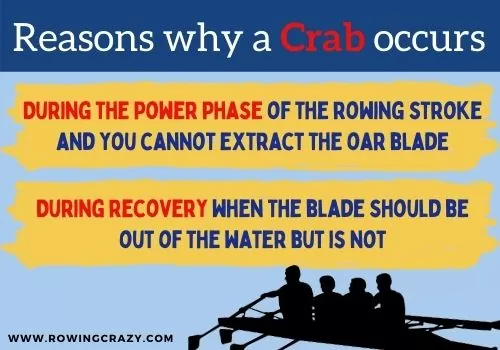
When I was very young, my parents would take me to regattas on occasion. I can remember them talking about someone “catching a crab” and I was confused.
I think the language we use is one of the things that make rowing such a fun and happy sport. So what is a crab in rowing?
A rower is said to “catch a crab” when he or she loses control of the oar, causing the boat to lose speed or even flipping the rower up and out of the boat and into the water.
About that little back story, I remember telling my mother that I didn’t believe there were any crabs in that lake, and she laughed out loud and insisted that on that day there was!
Of course, she wasn’t talking about those little crustaceans that crawl sideways. She was talking about the rowing term crab.
I’m Petra, and today, we are talking about something no one wants when rowing- catching a crab.
What Does a Crab Mean in Rowing?
About that little back story, I remember telling my mother that I didn’t believe there were any crabs in that lake, and she laughed out loud and insisted that on that day there was!
Of course, she wasn’t talking about those little crustaceans that crawl sideways. She was talking about the rowing term crab.
I’m Petra, and today, we are talking about something no one wants when rowing- catching a crab.
Basically, catching a crab in rowing is when the rower loses control of the oar. The oar handle swings backwards because the blade itself is trapped in the water by the movement of the shell.
This can cause the oar handle to swing up and over the rower’s head. The rower loses control and the boat loses speed.
Other times, the rower is holding onto the handle tightly and they get flipped up and out of their seat, sometimes landing in the water!
For many newbies, catching a crab is one of their biggest fears. It is not uncommon for newbies to catch a crab. I’ve told many noobs (people new to a sport) that they should actually welcome a crab so they can experience one and get it over with!
It’s very much like learning to ride a bicycle. It’s nearly impossible to learn to ride without falling at least once. To be honest, crabbing, like falling, is a valuable experience.
You will learn a lot if/when you catch a crab. Doing so allows you to move forward and focus on other things.
How Can You Avoid Catching a Crab?
The most common cause of a crab is usually that the blade is not square in the water.
This is either because the catch was not square to begin with or the rower was feathering the blade while it was underwater.
In most instances, both of these novice errors can be fixed quickly and simply.

The major problem occurs when novice rowers try to pull the oar handle lower into their laps during the finish, believing that this will bring the blade out of the water.
This actually gives you less space, not more. The opposite should be practiced. Pull the finish higher, not lower across your lap.
I know that this sounds like the opposite of what you are trying to accomplish, but try it slowly, and you’ll see exactly what I’m talking about.
Some coaches teach their students to leave a minimal amount of space between the blade and the water during recovery, but I have found this to be more of a hindrance than a help.
A bit of rough water or the wake from a passing boat is all that you need to catch a crab as the oar touches the water.
That’s strictly my opinion here, and if your coach encourages this tight clearance on recovery, then listen to your coach.
Wait! There’s More Than One Type of Crab?

Well, there are two reasons why a crab occurs.
- During the power phase of the rowing stroke and you cannot extract the oar blade – If the rower has sunk the blade deep underwater and cannot extract the blade, the force of the moving boat pushes the handle right into the stomach (or in some instances, it hits you right upside the head!)
- During recovery when the blade should be out of the water but is not – If the blade is not completely out of the water, the edge of the blade can hit the water at a bad angle, causing the boat to slow and in extreme cases, flip the rower right into the water.
Most rowers live in fear of a crab, but a cool head will allow you to handle one like a pro.
What Is the Best Way to Handle a Crab?
Everyone makes mistakes, even very experienced rowers.
If you find that you’ve caught a crab (and you’re still in the boat), the worst thing you can do is to fight with the handle.

Let go of the handle and leave the oar to itself. The movement of the boat will naturally allow the oar to rest parallel to the boat in a few seconds. Now the oar can be retrieved.
It’s a natural instinct to grab that handle and try to force the oar to do what you want, but doing this is a sure way to get yourself thrown overboard!
Let go of the handle and take control again when it’s safe.
This is the best way to avoid being thrown overboard, and it will slow the boat only a minimal amount.
The Bottom Line
Everyone makes mistakes, and if you’re an experienced rower, you’ve probably caught a crab more than once.
Newbies’ main problems are usually over- feathering, or they keep the blade underwater either too long or too far.

Many rowers are terrified of catching a crab, but they shouldn’t be. It’s usually easy to correct the problem, and no one ever died from catching a crab.
OK, maybe you’ll be embarrassed, and you might have to put up with some ribbing from other rowers or your crew, but that only lasts until someone else catches a crab!
Don’t let the common fear of catching a crab make you a nervous nelly.
Keep practicing and you will find that hard work pays off in wins, not crabs.
And even if you catch one today or tomorrow, it’s part of the fun! Whatever it brings you, enjoy rowing always!
Written by Petra Amara – RowingCrazy.com
CEO & Founder of RowingCrazy, National Rower, Coxswain Womens Eight Team, Rowing Coach & Writer
Petra is a Mother of two and owner of Rowingcrazy.com. Petra lives and breathes rowing, she also has a passion for writing which lead her to start RowingCrazy.com to share her rowing experience and expertise with others.






Pingback: Rowing Lightweight vs Heavyweight - What is the Difference?